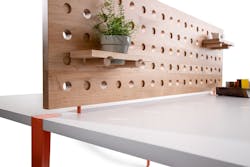You know specifying environmentally friendly furniture is important, but what does that really mean? One way to conduct a greener renovation is to choose furnishings and other materials that are reusable or recyclable when you’re done using them. Let these three strategies for reusing renovation materials inspire you to greener heights.
[Related: What is the Carbon Footprint of Interior Renovations?]
1. Reclaim Your Own Materials
Before you start your renovation, inventory your existing furnishings and materials and determine what you can reuse. Get creative—you may be able to save furniture, partitions or other products and use it somewhere else in your space.
If you can’t use a material again, consider donating it to a nearby architectural salvage program, such as Habitat for Humanity ReStore. These programs accept everything from appliances to building materials, resell them for a fraction of the retail price and use the funds to help build, rehab and repair affordable homes in your community.
2. Specify Durable Furnishings
With furnishings, being able to reuse products starts with specifying items that can stand up to years of use. Flimsier products may look good when they’re first specified but show their age quickly.
Mantra Inspired Furniture, which manufactures solid wood furnishings made by Amish craftsmen, creates tables, desks, storage and other office essentials that are made to stand the test of time.
“We hope that once you buy our furniture, you have it forever,” explained Susan Pilato, president and CEO of Mantra IF. “We’re not looking at ‘You buy it and you’re going to need it again in five years.’ That’s not our business model.”
The company recently became the newest maker added to Heirloom Design, a digital platform for refinishing and reselling commercial-grade furniture. Heirloom Design’s goal is to transform the current industry model by connecting makers and manufacturers with end users and designers who want to specify quality furniture that’s designed to last a lifetime.
3. Choose Recyclable Products
Some products can be returned to the manufacturer to be recycled into new products. Ceilume, which manufactures thermoformed rigid vinyl ceiling panels, is one manufacturer that recycles its old panels into new ceiling tiles or other products. The tiles are inspected for paint or glue residue, then ground up and inserted back into the raw material stream.
“We want to make the most efficient use of this resource that we can,” said Ed Davis, Ceilume’s president. “It is good for our company, it is good for the economy and it’s good for the planet. For us, recycling is a win-win-win.”
Ceilume’s closed-loop recycling program fits with the company’s mission, Davis added. Ceilume has been committed to recycling since it began thermoforming products in the 1970s.
“We like to keep it simple,” Davis said. “Just as we treat our customers with respect, we treat our raw material resources with that same respect. No business in the 21st Century can afford to squander either of them.”
About the Author
Janelle Penny
Editor-in-Chief at BUILDINGS
Janelle Penny has been with BUILDINGS since 2010. She is a two-time FOLIO: Eddie award winner who aims to deliver practical, actionable content for building owners and facilities professionals.

